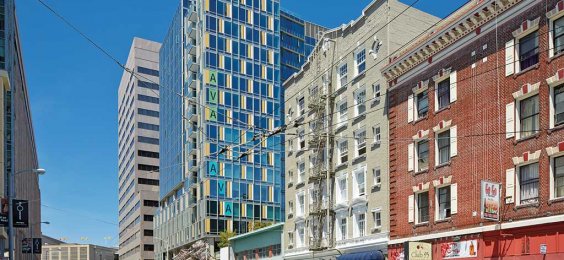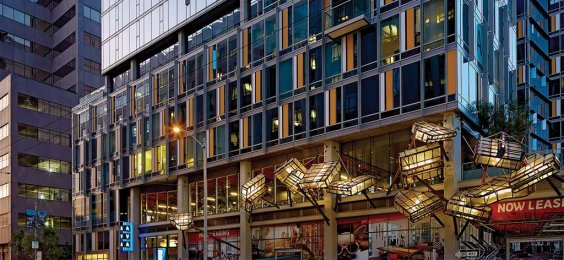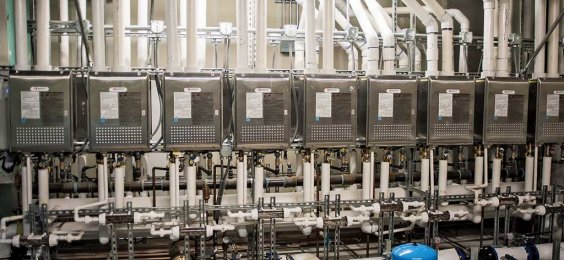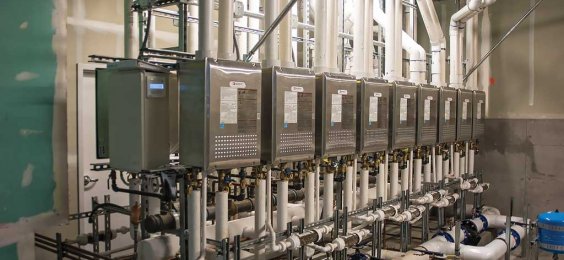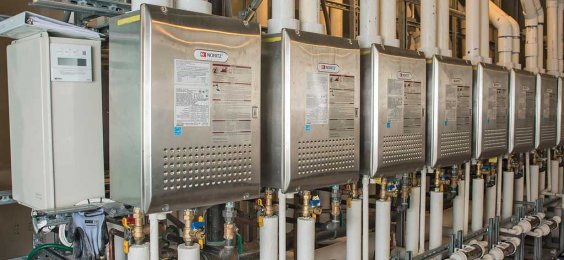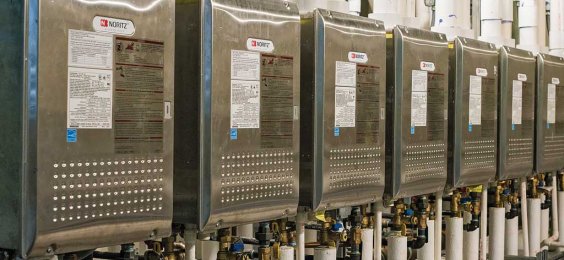Property Profile |
|
|---|---|
| Location | Ava 55 Ninth |
| City | San Francisco, CA |
Noritz Installation |
|
|---|---|
| Location | Utility Room |
| Applications | 18- Unit Wall Mount |
| Venting | Common Venting Polypropylene |
Noritz Heater Profile |
|
|---|---|
| Noritz Model | NCC1991DV |
| Fuel Type | Natural Gas |
| Min. / Max. Btuh | 16,000 – 3,598,200 |
AVA 55 Ninth Noritz Install
High-Efficiency, 18-Unit Tankless Water Heater System Helps 17-Story Apartment Complex Achieve LEED Gold Status
One of many sustainable features at the new AVA 55 Ninth, a 3.6 million BTU/HR DHW system meets the hot-water needs of 273-unit building with a flow rate of 104.6 gpm. Solar hydrothermal preheating system boosts water temperature to maximize efficiency, while multiple redundant units help avoid costly shutdowns for servicing.
SAN FRANCISCO (August 2015) — Tankless water heating technology has demonstrated its workability in a wide range of residential and commercial building projects over the past decade. The twin financial attractions of saving both energy and space – the units are frequently wall-hung and thus have a zero footprint – are the obvious drivers of this growth. In addition, many commercial building owners and managers have found the use of multiple, redundant tankless units to be an ideal strategy for applications – hotels, restaurants, etc. – that simply cannot afford to be without hot water even for an hour or two of maintenance.
But what about a large, high-rise, multifamily project with 273 apartments – studio, one- and two-bedroom units – on 16 levels, including a 3,300 square-foot fitness center, plus another 26,600 square feet on the ground floor, including 4,800 square feet of retail space?
- Can a tankless system meet the varying demands for hot water in a modern, urban community of this magnitude and complexity?
- And can it do so with a single, centrally controlled domestic hot water system, rather than each apartment having its own hot water-delivery appliance?
Tech Savvy Community
Opened in October 2014, the new AVA 55 Ninth high-rise apartment building in San Francisco’s Central Market neighborhood has clearly answered these questions in the affirmative. Built, owned and operated by the real estate investment trust AvalonBay Communities, Inc. (Arlington, Va.), the property combines tankless water heating with an array of sustainable features that recently enabled the property to earn a LEED Gold certification:
- low-flow drip irrigation systems that reuse rainwater collected in a cistern housed beneath a ramp leading to the building’s parking garage;
- high-efficiency toilets plus low-flow showerheads and bath and kitchen faucets in all the apartments; and
- waterless or low-flow urinals in the common areas on the ground floor.
A Silver honoree (“Most Tech-Savvy Community”) in the 2014 Multi-Housing News magazine’s Excellence Awards competition, AVA 55 Ninth also includes a number of informal “chill spaces” for encouraging socializing among the tenants. Besides the fitness center, the property offers an outdoor BBQ and dining area with a movie screen, a social media trending wall, a utility center to oversee resident electronics, and a 10,000-square-foot, landscaped courtyard. Bicycle parking stalls, a bike repair room, a pet-washing station and a dog run round out the amenities package.
Less visible, but no less crucial to the quality of tenant life, the innovative domestic hot water (DHW) system combines 18 separate, gas-fired tankless water heaters – all high-efficiency, condensing models with an Energy Factor of 0.95 – into a single cohesive operation. Made by Noritz America, the NCC1991-DV units are hung and piped together in a 16-ft. x 7-ft., custom-fabricated, Unistrut rack system located in a 1,000-square-foot, “penthouse” mechanical room on the roof of the building. Direct-vented with 4-inch PVC piping through a nearby wall to the exterior, each water heater ramps its outputs up and down with the building’s changing demand for hot water throughout the day. More on how the heaters synchronize with one another in a bit.
ACCO: Experienced with Tankless
The heater package was designed and installed by ACCO Engineered Systems of San Leandro, Calif. Lead plumbing engineer Kevin Hunt did the design in 2012, assisted by a lead coordinator and two technicians who handled the installation the following year. Hunt estimates that his work, done in consultation with the manufacturer’s Design Services department, required three days, with another five devoted to 3D modeling and coordination. Rack construction, heater hookup, and testing spanned roughly one week.
AVA 55 Ninth was not the first tankless system installed by ACCO. Hunt himself has worked successfully with the technology on several occasions since 2010. But 18 NCC1991 units at AVA 55 Ninth, each with a maximum gas consumption rating of 199,900 BTU per hour (BTU/HR), represented the largest ACCO had ever installed at that point and remains so in terms of the number of heaters. (More recently, ACCO completed an even more powerful installation of six, million-BTU/h tankless units.)
Building owners often have the final say on the domestic hot water system, and the driver is usually the sustainability goals of that same owner. In 2013, AvalonBay announced it would take a more comprehensive approach to “environmentally sustainable development.” Among its initiatives: providing tenants with energy labels for their apartments and energy-usage benchmarking in 48 of its communities “to enable more proactive decisions about building performance and maintenance needs,” according to an announcement. As of March 31, 2015, AvalonBay owned or held a direct or indirect ownership interest in 279 apartment communities, containing more than 81,600 units in 11 states as well as the District of Columbia.
“AVA 55 Ninth community is an excellent example of our deepened commitment to sustainability in our properties,” says Tony Joyce, project engineer for several AvalonBay properties, including AVA 55 Ninth. “Tankless technology was a good fit for this building, and it helped us achieve our goal of LEED Gold certification.”
Tankless was, in fact, the first choice at AVA 55 Ninth from the earliest stages of the design process, says Hunt. “We did look at a storage system for domestic hot water, but a number of managers on the project were actively pushing for tankless.”
The impetus, of course, was the anticipated energy savings and how these savings would help AvalonBay toward its goal of achieving LEED Gold. But other considerations played key roles in the decision-making process as well:
Solar System: The ACCO team also liked the way tankless would work with another of the building’s innovative, green features: a solar hydrothermal pre-heating system, installed to enable the structure to meet California’s stringent Building Energy Efficiency Standards (Title 24). By trimming the energy draw of the tankless water heaters, “the solar pre-heating system reduces the building’s overall energy consumption,” explains Joyce.
Here is how the system works, as designed by Sun Light and Power of Berkeley, Calif.:
Thirty-eight rooftop solar panels use a glycol-and-water mixture to collect and transfer heat to a 2,250-gallon basin, a closed system filled with water and located inside the mechanical room. A second, pumped loop transfers the heat in the basin water to the water entering the 18 tankless units nearby. As a consequence, the incoming water temperature is approximately 20 degrees warmer than it would be if it came straight from the ground.
The upshot? “The tankless system doesn’t have to work so hard bringing the incoming water to the setpoint temperature to meet demand,” Hunt remarks. “That temperature boost of about 20 degrees [Fahrenheit] saves even more energy and, we expect, extends the life cycles of the individual units.”
Redundancy: An apartment complex the size of AVA 55 Ninth typically uses hot water much like a large hotel: peak demand, or close to it, first thing in the morning, as tenants prepare for their day; low-level usage throughout the day while most tenants are away; a second, smaller spike in the evening when tenants return to do food preparation, dishwashing, bathing, etc.
That ever-fluctuating demand is why 18 heaters were used: Such a large number of units permit a more precise response to the hot-water usage habits of 273 different tenants.
When all 18 are fully operational, total consumption is 199,900 BTU/HR x 18, or 3,598,200 BTU/HR. Total flow rate: 104.6 gallons per minute.
Of course, actual demand is usually well short of that maximum, and sometimes (the middle of the night) there is comparatively little demand at all. But when a tenant does turn on a tap, shower or washing machine, she expects the hot water to flow all but instantaneously.
The AVA 55 Ninth system responds to that right-now need by having at least one tankless unit operating at all times, keeping water at a minimum temperature constantly circulating to all 273 units. As demand grows, the other 17 heaters fire in whatever sequence is required to meet it.
A single control unit, mounted on the rack and connected to all 18 heaters, smoothly orchestrates this sequencing process, making sure demand is fully met with minimum energy expenditure; i.e., no heater firing unnecessarily, providing more hot water than needed. “It’s not quite plug-and-play,” says Hunt, but the system controller (which can handle 24 units total) “made it easier to organize the hot and cold water lines as well as the gas and condensate connections in the rack, and then to set the system.”
Each NCC1991 has a minimum consumption of 16,000 BTU/HR. That calculates into a turndown ratio of 225 to 1 (3,598,200 divided by 16,000). The higher the ratio, the greater the capability of a system to adjust to the wide-ranging demand of a large, multi-family community.
“The high turndown ratio allows the system to maintain a steady water temperature even with a single unit running at only its minimum,” says Hunt. “This approach is much more efficient than a system that’s constantly cycling on and off. That kind of ‘short-cycling’ would result in significant – and noticeable – temperature fluctuations in water temperatures for the tenants.”
Meanwhile, the solar thermal setup allows this always-on system to still function efficiently by minimizing the energy needed to raise the temperature of water coming into the heaters. And absent any storage tank, there is no wasted energy beyond the heat lost through the building’s supply piping, as the water circulates through it.
One additional benefit of this redundancy cannot be overestimated. If any heater in the system needs maintenance, the other 17 will combine to pick up the slack. Except for absolute, peak-demand conditions, tenants should be unaware that any servicing is happening, let alone experience an interruption in the flow. Round-the-clock reliability is designed right into the system.
Other Cost Savings
Whatever concerns AvalonBay and ACCO had initially regarding the ability of a tankless system to meet the considerable hot water needs of AVA 55 Ninth, the system sizing and design phase answered them to everyone’s satisfaction.
“Sizing the system correctly was a major emphasis,” says Hunt, “so we took extra care – speaking with the local rep, working with the design team at Noritz, and using their online sizing calculator on top of our own calculations, based on ASPE [American Society of Plumbing Engineers] recommendations.”
One significant area of focus, because of the sheer size of the DHW system, was the diameter of the supply lines needed to bring gas to the water heaters. Early on, ACCO arranged for medium-pressure service, or 2 psi (pounds per square inch). “As a result, we cut the diameter of the gas piping from six inches to two and a half,” says Hunt, “which was a substantial cost saving.”
Tankless also provided another key cost-cut: because of their comparatively small size and weight, there was no need for a crane for placing the water heaters on the roof. The units were simply delivered to the building’s parking garage and then taken up on the service lift. “Eliminating the need for a crane was a major saving,” says Hunt, “and we didn’t have to worry about scheduling its use, either” – usually a major hassle on an urban job site because there’s so little room for staging deliveries.
From design to delivery to installation, to its subsequent performance for the tenants of this property, the tankless DHW system has proven to be a solid choice for AVA 55 Ninth, as well as for a growing number of commercial and multifamily projects.
“For ACCO, tankless is now an option on all projects,” says Hunt. “The big influences are the building owner’s priorities, of course, as well as what we think we can do with the system design. But if the specification calls for a storage tank, we might still assume tankless as an alternative. In any event, we increasingly lean toward tankless.”
JASON FLEMING serves as marketing and customer care manager for Noritz America, based at company headquarters in Fountain Valley, Calif. He can be reached at: (714) 433-2905 ext. 7813.
# # #
NORITZ AMERICA CORPORATION, a subsidiary of Noritz Japan, has corporate offices in Fountain Valley, Calif., and Atlanta, offering a full line of tankless water heaters to meet the hot water demands of residential and commercial applications. Noritz supports its products with a national network of skilled representatives and employees who are committed to providing the finest products and services to our communities by helping consumers live in a more comfortable, efficient and healthy lifestyle. For more information on Noritz America and the entire line of Noritz’s Energy Star® tankless water heaters, please call (877) 986-6748 or visit our website at www.noritz.com.
For editorial assistance, contact John O’Reilly at O’Reilly DePalma, 32 West Nebraska Street, Suite 1C, Frankfort, IL 60423; tel.: – 815.469.9100; e-mail – john.oreilly@oreilly-depalma.com

